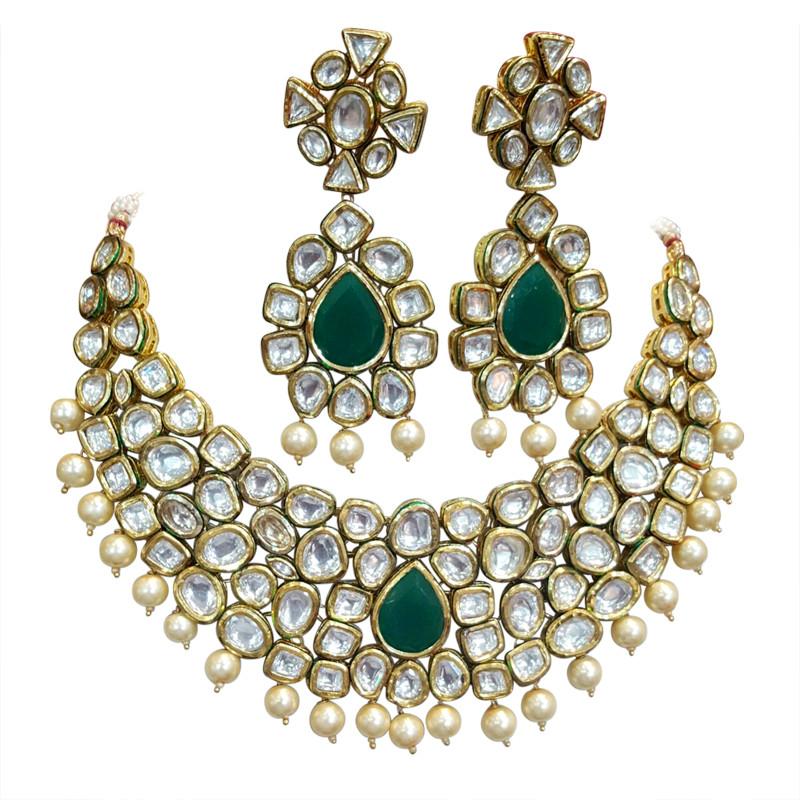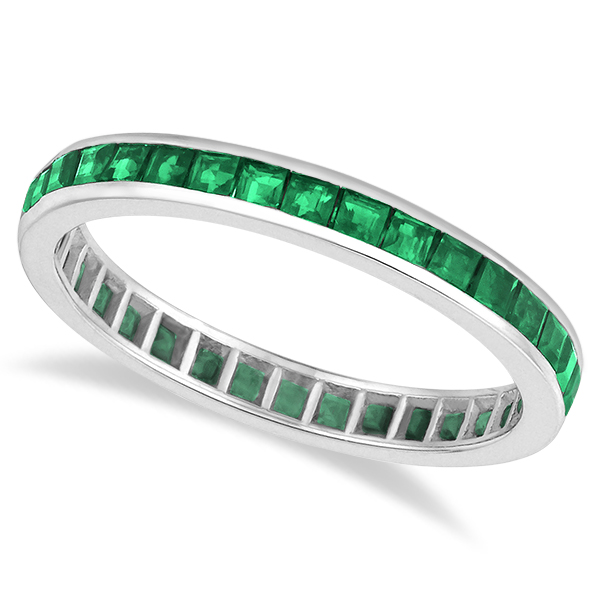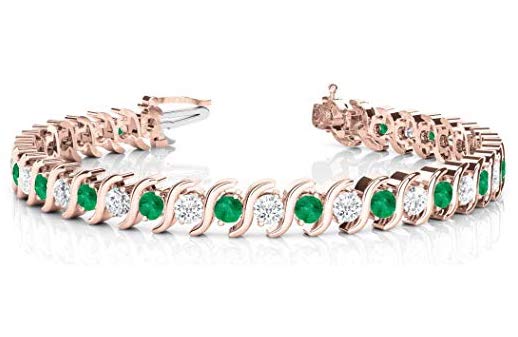Diversity in Modern Emerald Jewelry
Types Of Modern Emerald Jewelry

New jewelry-making technologies and global communication have given today’s emerald lovers more jewelry design options than ever before. The enduring beauty of the antique and vintage styles has spurred frequent revivals, and modern manufacturing and setting techniques have made jewels far more affordable than before.
The way we wear jewelry is diversifying as well. More European and American men are wearing jewelry, and we have developed many new jewelry fashions–including thumb rings, toe rings, and studs for body piercing. Emerald jewelry comes in a plethora of styles and forms. We have assembled a short catalog of modern designs to illustrate some of this diversity.
Emerald Earrings
Earrings come in a vast assortment of styles. The only limit to earring design is weight; they cannot be too heavy to wear with some degree of comfort. Another great virtue of earrings is motion. Even the simplest earrings—studs—come alive with the slightest turn of the head. Hoops, drop, and chandelier earrings move freely, causing emeralds and other faceted gems to dance and glitter.

Earrings have been worn by both genders since the beginning of recorded history. Since the 1980s, even conservative businessmen have come to embrace this ancient fashion. Studs and other earring-like jewels are also used to adorn body piercings, a new form of artistic expression among the younger generation.
Stud Earrings
Stud earrings seem fairly straightforward, but even simple studs require design choices. The key decision involves choosing how the stones–including emeralds–are set. Prong settings have a light and delicate appearance, and bezel settings are more substantial looking. Bezel settings also accentuate a gemstone’s apparent size, which can make them especially appropriate for smaller stones. Then there is the choice of metal–yellow gold versus white gold or platinum–depending on the wearer’s preferences and the color of the gems.

Earring Jackets
Jackets are add-on components that enhance stud earrings. Design options are almost limitless. A pair of emerald jackets can add a blaze of bright color to a set of neutral colored pearl or diamond studs.
Hoop Earrings
After studs, hoops are the simplest of all earring designs and they are often are set with colored stones such as emeralds. Designs vary, but all need to be lightweight to be comfortable. Mothers of small children avoid large hoop earrings because tiny hands may grasp at their intriguing sparkle.

Drop Earrings
Drop earrings offer designers many options for displaying precious stones such as emeralds. These earrings typically have a section that hugs the ear, with one or more segments suspended from it. Drop earrings have great movement, and they can be casual or dressy depending on the occasion.
Chandelier Earrings
Chandelier earrings are an elaboration of the dangle or drop earring. Chandeliers are relatively long, large earrings that feature tier upon tier of small drops in a fine textured, open arrangement. Although they have been overwhelmingly popular for the last several years, the design has been used for centuries.
Contemporary chandelier earrings have renewed interest in briolette cuts, which were fashionable in Victorian and Edwardian jewelry. Chandelier earrings featuring emerald briolettes are especially stunning when worn on dressy occasions.
Emerald Rings

Rings are the most popular jewelry item in today’s market. They’re convenient to wear, they show off single stones to advantage, and their wearer can enjoy seeing them as easily as anyone else. They also hold a great deal of symbolic power. If you have an interest in amulets and talismans, birthstones, healing stones, religious stones, and spiritual stones, the emerald ring you choose can reflect many of your personal ideals and preferences.
Rings represent continuity, commitment, and loyalty. The traditional engagement ring has spread as far as China and Japan, making it the most prized item in many jewelry wardrobes. Emeralds are a perfect choice because they are associated with love and fidelity.
As North American, European, and East Asian men begin to wear more jewelry, men’s rings are occupying more space in jewelers’ inventories. Contemporary men’s rings often feature bold geometry and clean, crisp lines, although adventurous and confident men are beginning to experiment with more elaborate designs as well.

For all of their advantages, rings present one or two challenges to the wearer. Because we use our hands regularly, rings are more vulnerable to wear than most other articles of jewelry. Over the past few years, the public has been introduced to the concept of “right hand rings.” Since the majority of the population is right-handed, these rings must be able to withstand considerable wear.
Some jewelers discourage their customers from buying emerald rings if they are intended for everyday wear. Although emerald is considered very durable, some consider a top quality emerald too rare and valuable to be worn as rings. Emerald has a hardness of 7.5 to 8 on the Mohs scale, which means it is resists scratching. However, emerald is not as tough as it is hard. Emerald can be brittle, especially if it is heavily included. Although it is not common, an emerald can also experience imperfect cleavage parallel to the basal plane of the crystal.
Variations in ring style and structure are too many to catalog in full, but we’ve included a few especially popular styles below:
Band Rings
The band is one of the oldest and simplest ring styles. Popular setting techniques for band rings include channel setting, bezel setting, and pavé setting. Variations on the band theme are many. One of the best loved is the eternity band, which is completely encircled by small, channel set stones. Stacking eternity bands in diamond, sapphire, emerald, and ruby are very fashionable today.

EJ261 | small | “The center emerald is completely wrapped in metal, which is the bezel setting. It is also pave due to the multiple diamonds, as well as channel because of how they are set.”
EJ179 | small | “A pave setting made up of numerous diamonds. The emerald center stone is not a pave because there is only one gem.”
Solitaire Rings
Like the band ring, the solitaire is a simple, classical style. While the band ring emphasizes metal or closely set small stones, the solitaire is meant to exhibit a single central stone of superb quality. In its purest form, the solitaire ring consists of a plain band supporting a prong set center stone. In some contemporary solitaire rings the central stone is bezel set, which serves to increase the apparent size of the center stone. Another modern variation is the striking tension set ring, where the stone seems to float in midair.

Three-Stone Rings
The three-stone ring is a favorite among emerald lovers. In a three-stone ring, two well-matched accent stones flank a center stone, and emeralds are often accented with diamonds.
Cluster Rings
Instead of a single centerpiece stone, cluster rings feature groupings of smaller stones, arranged in an artful pattern. Cluster rings can be set with multiples of a single type of gemstone or with an assortment of stones. Emeralds are often combined with diamonds in cluster settings, but may also be accompanied by any number of other colored stones. Cluster rings often mix stones of different shapes, including rounds, ovals, pears, and marquises. Using smaller stones in clusters makes a generous display of gems more affordable, since several small stones will cost less than a large single stone.

Bombé Rings
The bombé ring is a variant of the cluster ring, featuring a dome of small, closely set stones, with or without a prominent center stone. The style was popular during the 1920s and 1930s, and reemerged during the 1980s. Bombé rings garner lots of attention, especially when set with dazzling stones such as emeralds.
Emerald Pendants and Necklaces
Jewels worn around the neck are often the largest and most conspicuous. Stones too large to wear comfortably in a ring or in earrings can be suspended from the neck with little discomfort or impediment to movement. The terms “necklace” and “pendant” are often used interchangeably, but necklaces and pendants are in fact two distinct things. A necklace is a piece of jewelry worn around the neck. A pendant is a jewel that is worn suspended from a necklace.

Emerald Pendants
A simple, single-stone pendant can be an effective way to show off an emerald, and it is appropriate for any occasion. The quality of single stone pendant depends on the quality of the gemstone. A lively, well-cut stone with vivid color will always make the best impression. Small diamond accents can help draw attention to the center stone and enhance the sparkle, if the proportions remain appropriate.
Pavé set emerald pendants offer an economical way to make a big splash with small stones. For a more elaborate effect, an emerald pendant can be adorned with a drop, which may be removable and set with gems of any kind. Diamonds and pearls work especially well when dangling beneath an emerald.

Emerald Necklaces
Emerald necklaces range from discreet and simple to conspicuous and opulent. The design possibilities for emerald necklaces are almost limitless, but there are a number of common styles that are worth specific mention. Necklaces are distinguished both by dimensions and construction.
A collar is a broad, often solid piece of jewelry that rides close to the neck. A dog collar necklace is a wide strap of chains, pearls, or beads that snugly encircles the neck.
A choker is a flexible, single or multi-strand necklace that is looser and longer than a collar, hanging just at the hollow of the throat. Chokers are usually 14 – 16 inches long.

Princess length necklaces are 17-19 inches long and hang right below the hollow of the throat. This length is particularly versatile and can be worn with a variety of necklines.
Most of the longer lengths refer to pearl strands or bead necklaces: matinee at 20-26 inches, opera at 27-34 inches, and rope at 36 inches or more.
An emerald necklace that includes two pendants of unequal length is called a lavalier, after Louise de Lavaliere, a mistress of the French King Louis XIV who apparently favored the style. The Art Deco sautoir is a long necklace, usually made of beads, which has a tassel or a pendant at the end.

Emeralds can also appear in lariat style necklaces, where the two decorated ends of an open chain are tied, clipped, or otherwise fastened together and left to dangle side by side.
Emerald line necklaces feature single or multiple rows of stones that run all the way around the neck, sometimes arranged in graduated sequences. Graduated necklaces of faceted emerald beads or briolettes are now fairly common in jewelers’ inventories.
One of the most elaborate necklace styles is the garland or bib, which drapes across the wearer’s chest and can potentially house many carats of emeralds or other precious stones. Elaborate bib necklaces set with rubies, sapphires, emeralds, diamonds, and pearls are especially characteristic of the Mughal and Mughal revival styles.
Emerald Bracelets

Bracelets, like rings, are subject to knocks and scrapes, so they’re best set with highly durable stones. For this reason, bracelets set with emeralds are not as common as ones set with other precious stones. With proper care however, we believe your emerald bracelet will last for many years to come. Emerald bracelets are constructed in any number of ways, from simple strings of emerald beads to a series of complex metal links set with emeralds and other precious stones.
Bangles and Cuffs
In terms of structure, the simplest emerald bracelets are the cuff and the bangle. In its most basic form, a bangle is a metal hoop just wide enough for the hand to slip through. In order to fit over the hand, bangles must be larger in diameter than the wrist, which allows them to move when worn. The motion of a bangle on the wrist can highlight the brilliance of faceted gems, but it can also interfere with daily activities, including writing and eating. To allow for a closer fit, many bangles are hinged so that they can fit over the hand in the open position, yet remain relatively still on the wrist when closed.

The cuff bracelet is a variation of the bangle. Like the hinged bangle, the cuff fits over the hand but hugs the wrist or arm. Cuffs and bangles are among the oldest bracelets known. Examples have been found in Egyptian tombs, and both types were worn in ancient Greece and Rome. Cuffs and bangles were also worn in ancient Africa, China, and India, where they remain highly fashionable today.
Bead Bracelets
The most conspicuous of emerald bead bracelets is the torsade , which consists of multiple emerald bead strands twisted together to form a sort of gemstone rope. Bead bracelets and torsades can be comfortable to wear, even when fitted closely to the wrist. One inconvenience of bead bracelets, especially the looser fitting ones, is that a strand may snag and break. As with pearls, emerald bead strands should be knotted between each bead to prevent all of them from spilling if the strand breaks.

Link Bracelets
Among emerald-set link bracelets, the simplest is the line bracelet, which is no more than a single row of prong or bezel-set emeralds entwined around the wrist. These are also widely known as tennis bracelets, even Link bracelets set with colored stones were a specialty of French jewelers during the 1920s and 1930s.
Emerald Clips, Pins, and Brooches

Clips, pins, and brooches were once far more common than they are today. Before the rise of buttons and zippers, they were the primary means of fastening garments. Only those with considerable rank and wealth could decorate their clips and pins with emeralds, so an emerald-clad fastener was a conspicuous status symbol.
As vehicles for displaying gems, clips, pins, and brooches offer particular advantages. They are not liable to experience hard wear or frequent impacts. Like earrings and necklaces, they can be worn near eye level for easy visibility. And they are one of the best ways to display especially large emeralds. On the other hand, most clips, pins, and brooches pierce or crimp a garment, which makes some jewelry-lovers hesitant to wear them, especially on their best clothing.
Emerald Shirt Studs and Cufflinks
Functional considerations keep most cufflinks relatively small. Like bracelets, they are subject to impact during daily wear, and durable stones are preferred. One common way of using emeralds in cufflinks is to set them in invisible settings where no prongs, rails, or bezels are apparent.

Shirt studs are typically made in sets of four to six to coordinate with cufflinks. Complete stud and cufflink sets in popular styles like Art Deco are favorites with sophisticated jewelry collectors, as are old sets by renowned designers such as Cartier, Buccellatti, and Fabergé.
Like pins, clips, and brooches, shirt studs and cufflinks were indispensable before the advent of buttons and zippers. But because of their enduring role in formal menswear, they are still an important part of the jewelry market. In fact, they are often the only pieces of jewelry that a man will own—aside from his wristwatch and wedding ring.
With so many options in emerald jewelry, it’s important to understand the most important considerations. Learn about those next in our Buying Tips.
